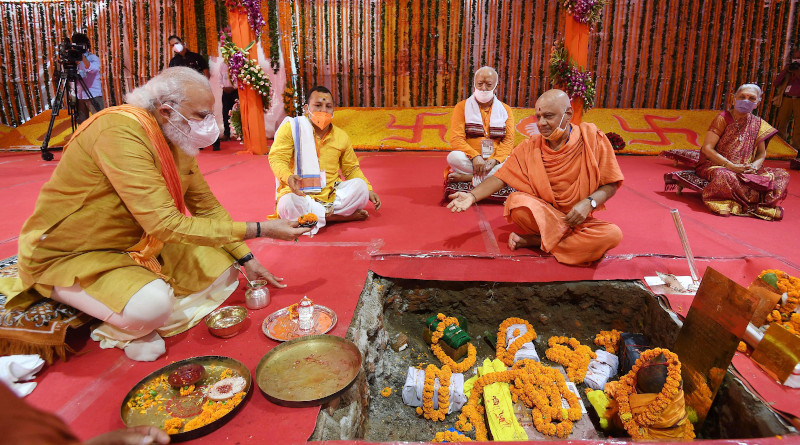Ayodhya’s Transformation Amidst The Ram Mandir Controversy – OpEd
The city of Ayodhya, known for its deep-rooted religious and cultural significance, finds itself entangled in a web of complex issues—historical injustices, economic disparities, and communal tensions—amidst the controversial construction of the Ram Mandir on the site of the Babri Mosque. This multifaceted dilemma demands a nuanced exploration of the socio-political, economic, and ethical dimensions that shape Ayodhya’s evolving landscape, particularly impacting its Muslim community.
The Babri Mosque’s demolition in 1992 ignited communal conflagrations, precipitated legal battles, and ultimately culminated in the Supreme Court’s polarizing 2019 verdict endorsing the construction of the Ram Mandir. This landmark decision, viewed as a miscarriage of justice by many in the Muslim community, symbolizes historical injustices, entrenched divisions, and unresolved grievances that continue to haunt Ayodhya’s socio-political fabric. The Babri Mosque, a beacon of Muslim heritage and religious reverence, remains an indelible emblem of Ayodhya’s contested history, communal strife, and simmering tensions.
Ayodhya’s ambitious redevelopment initiatives promise economic rejuvenation, global recognition, and infrastructural transformation but inadvertently perpetuate systemic inequalities, economic disparities, and social exclusion, particularly affecting the city’s marginalized communities. Skyrocketing land prices, inadequate compensation for displaced residents, limited access to economic opportunities, and eroding livelihoods exacerbate socio-economic disparities, perpetuate cycles of poverty, and deepen communal divisions. While affluent stakeholders, influential elites, and corporate entities reap the benefits of Ayodhya’s economic resurgence, marginalized communities, including the Muslim population, confront economic precarity, systemic barriers, and diminishing prospects.
The BJP’s unwavering commitment to the Ram Mandir’s construction aligns with its broader Hindu nationalist agenda, privileging religious symbolism over secular governance, communal harmony, and social justice. This calculated political maneuvering marginalizes Ayodhya’s Muslim community, fosters communal divisions, undermines democratic principles, and perpetuates cycles of exclusion, disenfranchisement, and communal discord. The relentless politicization of Ayodhya’s redevelopment initiatives, cultural heritage, and historical narratives erodes social cohesion, fosters polarization, and exacerbates communal tensions, necessitating ethical scrutiny, democratic accountability, and inclusive governance.
Global Narratives: Cultural Commodification, Historical Erasure, and Ethical Imperatives
As Ayodhya emerges as a focal point of international attention, pilgrimage tourism, and investment, the commodification of its religious heritage raises profound ethical concerns regarding cultural appropriation, historical erasure, and systemic exclusion. Corporate conglomerates, hospitality giants, and international investors capitalize on Ayodhya’s religious significance while marginalizing its Muslim community, eroding cultural diversity, historical truths, and shared heritage. This commodification perpetuates economic disparities, reinforces exclusionary practices, undermines Ayodhya’s cultural richness, diversity, and communal harmony, necessitating ethical scrutiny, cultural sensitivity, and inclusive development strategies.
Ayodhya’s transformative journey necessitates a comprehensive, multi-dimensional approach that prioritizes social equity, communal harmony, historical justice, and inclusive development. Addressing the Ram Mandir-Babri Mosque controversy mandates acknowledging past injustices, fostering reconciliation, advocating for policies, initiatives, and programs that empower marginalized communities, including Ayodhya’s Muslim population.
Stakeholders, including government entities, civil society organizations, religious leaders, and community representatives, must collaboratively challenge systemic exclusion, dismantle barriers to economic opportunity, promote dialogue, understanding, and mutual respect among diverse groups. Investing in education, healthcare, infrastructure, affordable housing, cultural preservation, and community development initiatives can catalyze inclusive growth, foster social cohesion, and uphold democratic values, principles, and aspirations.
Ayodhya’s transformation encapsulates the complexities, controversies, and contradictions inherent in India’s diverse, dynamic, and evolving socio-political landscape. Navigating this intricate terrain requires courage, compassion, collaboration, and a collective commitment to justice, equity, communal harmony, and inclusive development. As Ayodhya confronts its past, grapples with its present, and envisions its future, stakeholders must prioritize inclusive development, historical reckoning, cultural preservation, and social cohesion. Only through ethical governance, equitable policies, participatory decision-making, and mutual respect can Ayodhya realize its potential as a symbol of unity, prosperity, shared heritage, and inclusive progress for all its residents, irrespective of their religious, cultural, socio-economic, or political affiliations.

